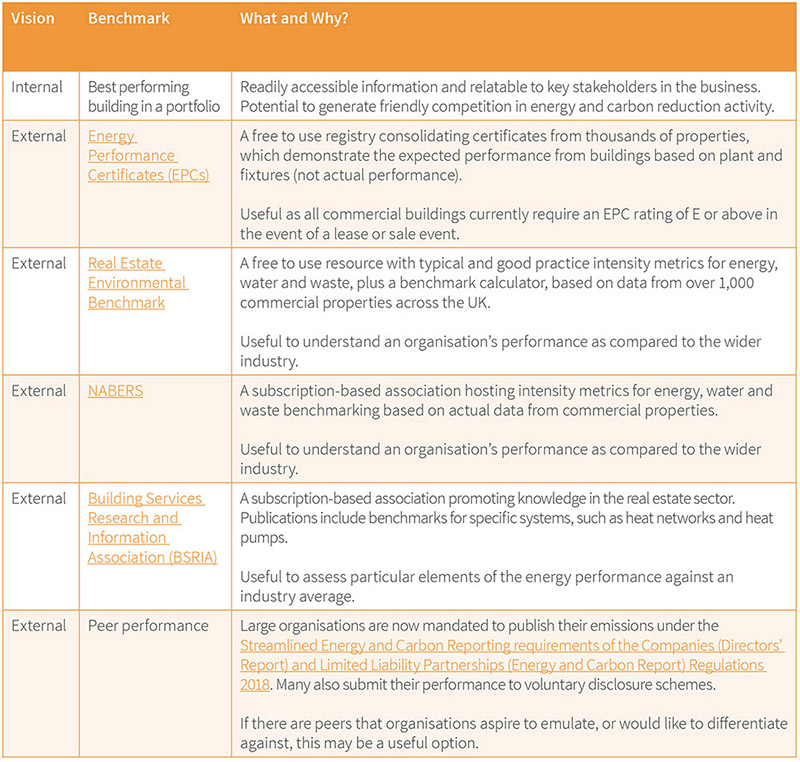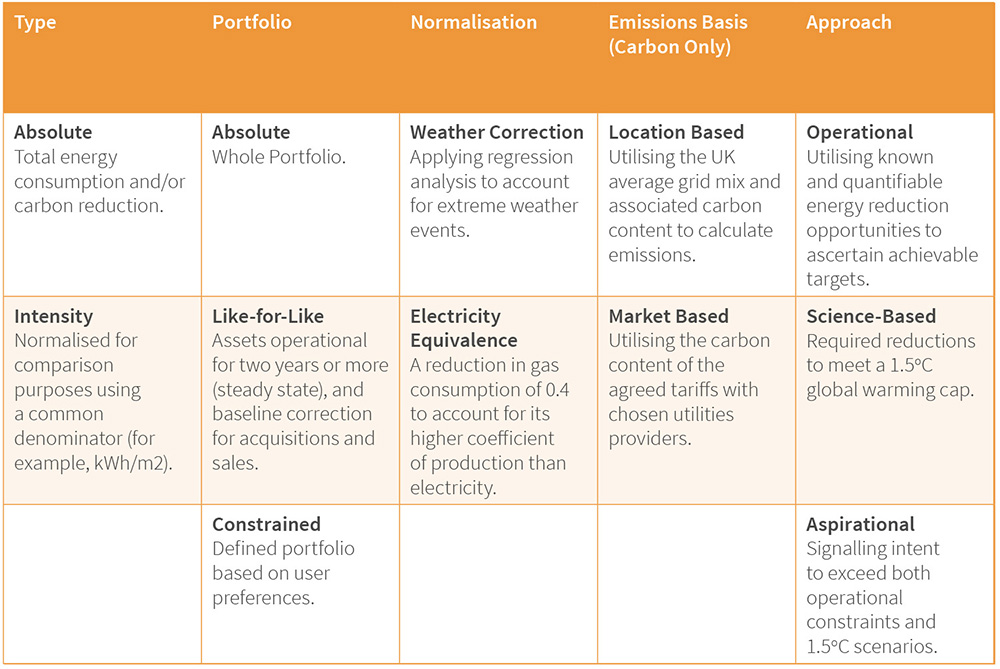GN 4.7: Benchmarking energy use and setting targets
Guidance Note purpose
The purpose of this Guidance Note is to provide asset managers, property managers and facilities managers with information relating to benchmarking energy usage and setting energy saving targets within commercial properties.
Context
The real estate sector continues to make progress in decarbonising the built environment. Like any area of performance management, establishing benchmarks and monitoring targets can demonstrate that practical actions are succeeding in delivering energy savings, and that organisations are making progress towards their carbon commitments.
It is important to distinguish between a benchmark and a target.
- A benchmark is a point of reference which acts as a comparison to something similar.
- A target is a qualitative or quantitative outcome that an organisation aims to achieve in the future. Targets should be ‘SMART’: Specific, Measurable, Achievable, Relevant and Timebound.
Importance
Targets are important as they enable performance to be monitored and can help to align a company’s focus with statutory requirements. For example, the UK government has set national carbon reduction targets through the Climate Change Act 2008:
- Reduction of 68% by 2030, compared to 1990 levels.
- Reduction of 78% by 2035, compared to 1990 levels.
- Reduction of 100% by 2050, compared to 1990 levels.
The launch of the World Green Building Council’s Net Zero Carbon Buildings Commitment in September 2018, introduced an ambitious, shared target for the real estate sector:
“Net zero carbon in operation for all assets under their direct control by 2030, and to advocate for all buildings to be net zero carbon in operation by 2050.”
Benchmarks provide a useful tool which can help to ascertain:
- A company’s performance versus peers, or industry standards.
- A property’s performance against a similar type, or portfolio.
In turn, the understanding provided by benchmarking can inform the level of ambition and corresponding targets.
Energy targets are also a core component of a submission of climate change activity to voluntary disclosure schemes. Relevant schemes for real estate include, for example:
- The Carbon Disclosure Project (CDP).
- Global Real Estate Sustainability Benchmark (GRESB)
- European Public Real Estate Association’s Sustainability Best Practice Recommendations (EPRA sBPR).
For all participants in these schemes, disclosure of energy performance offers an opportunity to benchmark wider sustainability performance against peers, and the potential to enhance their brand, if performance is favourable.
For stock-exchange listed companies, which are often included in environmental and social governance exchange traded funds, participation in voluntary disclosure schemes creates an additional financial incentive.
Responsibilities & Interests
The table below summarises the key activities associated with benchmarking and setting energy targets, and highlights where asset managers, property managers and facilities managers are likely to have a responsibility or specific interest.
- AM - Asset Manager
- PM - Property Manager
- FM - Facilities Manager
Benchmarking: 1. Review materiality
Stakeholder:
Benchmarking: 2. Normalise benchmarking data
Stakeholder:
Benchmarking: 3. Consider appropriate benchmarks
Stakeholder:
Setting Targets: 1. Consider external and internal drivers
Stakeholder:
Setting Targets: 2. Consider boundaries and normalisation
Stakeholder:
Setting Targets: 3. Understand the relationship between energy and carbon
Stakeholder:
How to
Intro
Usually, the decision to participate in a benchmarking scheme, or to set property or portfolio energy targets, is taken by an asset manager. The process of collating information that will inform this decision is coordinated by the property manager with input from the facilities manager.
Key considerations for benchmarking and setting energy targets are described below:
- AM - Asset Manager
- PM - Property Manager
- FM - Facilities Manager
Benchmarking: 1. Review materiality
A materiality review is an exercise that evaluates the impacts of the business across a range of potentially relevant topics and considers the extent to which those impacts are important to the business and its stakeholders.
Knowing what is expected of the business, both internally and externally, will help to decide what benchmarks are appropriate. The outcomes from a review of materiality can inform future benchmarking decisions. For example:
- If an organisation owns a small portfolio of assets which are already equipped with high performance energy saving and renewable generation measures, climate change may be less material to the business than for others, for example, a larger, more energy-hungry portfolio. Hence, the need for benchmarking data to inform further energy investments may be limited.
- Conversely, stakeholder perceptions may be sufficiently important to merit undertaking a benchmarking exercise to provide evidence of the relatively high performance of the portfolio. This can help to demonstrate that the business is one that strongly supports climate change mitigation.
Benchmarking: 2. Normalise benchmarking data
Before proceeding with a benchmarking exercise, it is important to normalise energy benchmarking data, where possible. Unlike an absolute benchmark, a normalised energy benchmark facilitates a like-for-like comparison with other properties or portfolios.
Normalisation can be delivered via a range of metrics, including, for example:
- Kilowatt hours per capita (for example, employee, footfall).
- Kilowatt hours per unit of occupied space (for example, m2, sq.ft).
- Kilowatt hours per unit of revenue (for example, £).
Benchmarking: 3. Consider an appropriate benchmark
It is important that a benchmark aligns with a property or portfolio’s business strategy. This involves considering whether the benchmark should be inward or outward looking.
For example, if an organisation is new to energy and carbon management, choosing to benchmark performance against a peer that is well established is likely to yield results that illustrate organisational underperformance against the benchmark.
This has the potential to disengage key stakeholders, who may see the process as a futile exercise, and could also harm the brand if the benchmarks are made public. Equally, choosing an internal benchmark, i.e., comparing against other properties within a portfolio, may be perceived as conservative or unambitious.
The following are all useful benchmarking options that could be considered:

Setting Targets: 1.Consider external and internal drivers
As with benchmarking, the outcomes from a materiality review will inform energy target decisions. Alongside this, it is important to consider legislative and scientific requirements that influence a property or portfolio’s energy target.
For example, the UK Government and World Green Building Council are advocating net zero carbon by 2050, with interim targets for 2030 and 2035. While there are a number of ways to achieve this without relying entirely on energy reduction, this provides useful context to help frame energy targets.
Organisations can, of course, decide to choose other targets which could demonstrate ambition beyond operational and scientific boundaries, such as net negative.
The Science Based Targets Initiative helps organisations develop targets that are “in line with what the latest climate science deems necessary to meet the goals of the Paris Agreement – limiting global warming to well-below 2°C above pre-industrial levels and pursuing efforts to limit warming to 1.5°C.”
It is also important to consider how an energy target is set based on what is possible within strategic, budgetary and infrastructural constraints. This includes understanding what action, and investment, would be required to achieve the target, and considering the extent to which this resource, and the required actions, are is achievable.
Understanding the energy consumption profile of a property or portfolio, and the potential contribution that may be available through different energy saving opportunities, can inform a decarbonisation pathway and incremental targets within it.
Ideally, a target should combine both external and internal drivers.
- Short to medium-term targets based on known opportunities.
- Long-term targets recognising the potential for product and service innovation that may yet involve unknown quantities, or wholesale strategic change that offer energy and carbon reduction opportunities which are not immediately available.
Setting Targets: 2. Consider boundaries and normalisation
Energy targets should always be applied within a defined boundary. For example, organisations may decide to take:
- A whole portfolio approach, but should recognise that acquisitions and divestments may impact on performance and hence the ability to meet those targets.
- A like-for-like approach, where performance is normalised to account for acquisitions and divestments, by adding or removing associated consumption to a baseline.
- A steady state buildings approach, so that vacant buildings and those where building controls aren’t fully understood or employed, represent a more consistent approach to energy performance and target setting.
Normalisation doesn’t only apply to an organisational boundary, but also to the reported energy consumption. For example, extreme weather events can cause consumption to rise and fall disproportionately in comparison to weather remaining consistent year-to -ear.
Setting Targets: 3. Understand the relationship between energy and carbon
When setting an energy or carbon target, it is important to recognise that there is not a one-to-one relationship between energy and carbon reduction performance.
Decarbonisation is, of course, impacted by energy reduction. However, the carbon factor of the UK’s electricity mix is decreasing, as more renewable generation comes on stream and displaces fossil fuels, such as coal and gas.
As a result, the carbon content of a kWh of electricity has dropped by 49% in the last 10 years. Organisation may therefore decide their carbon targets should be more stringent than their energy targets, to account for grid decarbonisation.
The following are all useful target setting options that could be considered:

Related Guidance Notes
The following Guidance Notes contain related information:
- GN1.3: Risk context
- GN2.3: Sustainability reporting
- GN3.1: Ratings and certifications
- GN4.4: Advanced metering
- GN4.5: Energy consumption profile
- GN4.8: Template action plan
- GN4.9: Energy efficiency improvements
- GN4.12: Energy performance monitoring
Additional Resources
- BBP Real Estate Environmental Benchmark
- Building Services Research and Information Association (BSRIA)
- Energy Performance Certificate Registry
- National Australian Built Environment Rating System
- Science Based Targets Initiative
- Streamlined Energy and Carbon Reporting Guidelines
- Carbon Disclosure Project
- Global Real Estate Sustainability Benchmark
- European Public Real Estate Association
- Climate Change Act 2008
Solutions Scrapbook
Accordion
Here is some text
MAP members piloted the submission of data from their managed portfolios for the first time in 2020. Following the successful pilot, we will now be working with MAP members to expand the dataset.
test
Data on actual operational performance is not easily obtainable or delineated to ensure appropriate accountability for performance and drive improvement.
Head of Sustainability Engagement
- Are you passionate about delivering industry wide sustainability projects, to drive sector wide transformation?
- Would you enjoy interacting and collaborating with high profile stakeholders and market leading organisations?
- Are you determined to make radical collaboration across the real estate industry a reality?
- Does achieving net zero carbon buildings by 2050 with the largest commercial property owners in the UK excite you?
Benefits:
Head of Sustainability Benchmarking & Measurement
- Do you believe accurate data is imperative to driving sustainability and ESG transformation within real estate?
- Would you enjoy working with key industry stakeholders and organisations to develop benchmarks and methodologies that are utilised across the industry?
- Does achieving net zero carbon buildings by 2050 with the largest commercial property owners in the UK excite you?
If so, this could be the ideal opportun
Benefits:

Refurbishment
MAP members piloted the submission of data from their managed portfolios for the first time in 2020. Following the successful pilot, we will now be working with MAP members to expand the dataset.